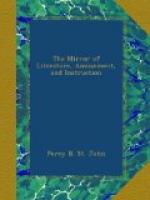It is a remarkable fact in the economy of nature, that of those birds whose nests are the most liable to discovery, and whose eggs are most exposed to observation from the form of the nests, the eggs are of that colour which is the least different from the surrounding objects; whilst those birds whose eggs are of a bright and positive colour, hide their nests in the hollows of trees, or never quit them, excepting in the night, or sit immediately that they have laid one or two eggs. It is also to be observed that of those species which build an exposed nest, and the females of which alone perform the duty of incubation, the colour of the female is much less bright than that of the male, and more in harmony with the objects by which she is surrounded during the period in which she sits upon her eggs. It would seem, therefore, that those birds which lay a brightly-coloured egg have the instinct to make a close nest, or to place it in the least exposed situations; while those which lay a sober-coloured egg are less solicitous to conceal it from the notice of their enemies. M. Gloger, a German naturalist, has paid great attention to this curious circumstance, and has very recently published an elaborate memoir, in a work printed at Berlin, in which he notices the habits of all the species of birds indigenous to Germany, in confirmation of the theory. Our limits will not allow us to notice the particular species which he enumerates; but it may be sufficient to excite attention to this subject, to mention, that the birds which lay an egg perfectly white (the most attractive of colours) make their nests in holes of the earth, and cavities of trees, such as the kingfisher and the woodpecker, or construct them with a very narrow opening, as the domestic swallow; that the same coloured egg is found amongst the birds which scarcely quit their nests in the day, as hawks and owls; and that such birds as doves, which only lay one or two eggs, and sit immediately after, have their eggs white. The bright blue or bright green egg belongs to birds which make their nests in holes, as the starling, or construct them of green moss, or place them in the midst of grass, but always well covered. The eggs of many gallinaceous birds, that make their nests carelessly in the grass, are of a pale and less decided green, such as those of the partridge and pheasant. Of the mixed-coloured eggs, those of which white forms the ground belong to birds that make very close nests. Speckled eggs, with a dark or dirty ground, belong to the largest number of species. Almost all the song birds lay such eggs; and building open nests, they almost invariably line the inside of them with materials of a harmonious colour with the eggs, so that no evident contrast is presented which would lead to their destruction.—Companion to the Almanac.
* * * * *




